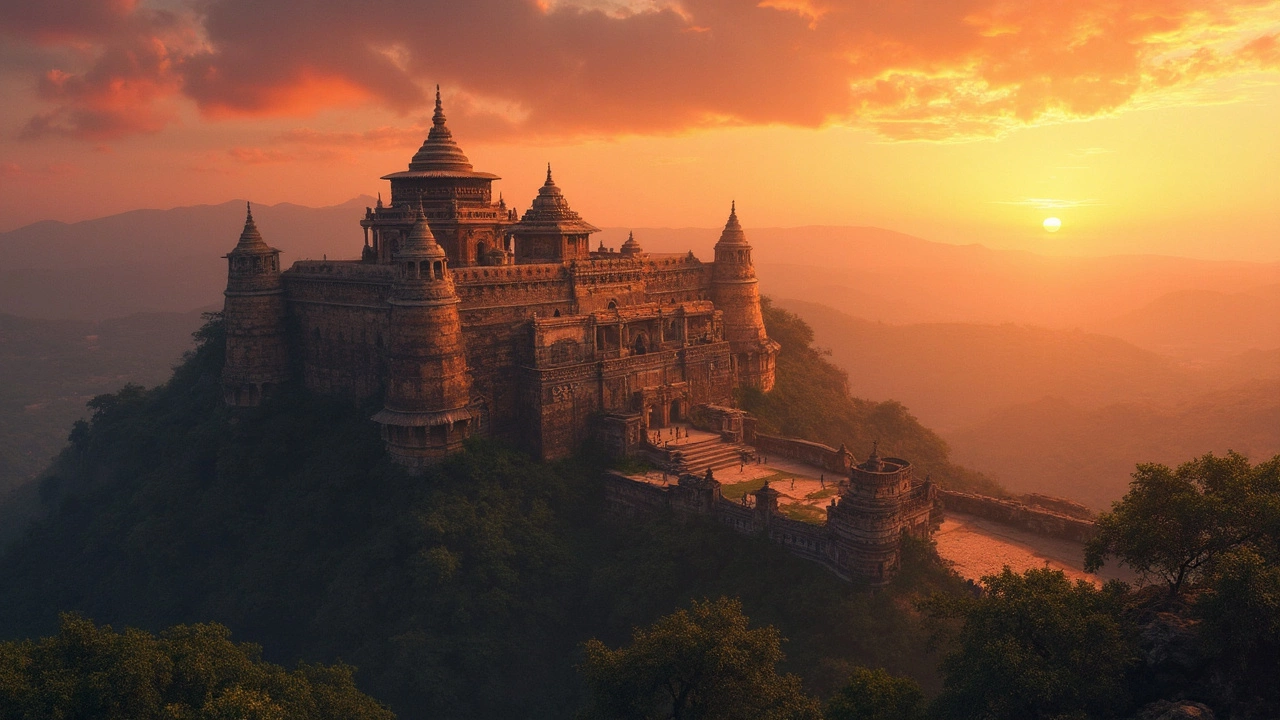Which Country Has the Most World Heritage Sites? Hint: It's in Asia
 Feb, 5 2025
Feb, 5 2025
Did you know that India is a treasure trove of World Heritage Sites, boasting the most in Asia? When people think of cultural riches, places like France and Italy often come to mind, but it’s India that surprises many with its staggering number of UNESCO-recognized sites. From architectural wonders to breathtaking landscapes, it’s no wonder the country attracts millions of visitors every year.
Besides the famous Taj Mahal, India is home to the ancient rock-cut caves of Ajanta and Ellora, the majestic Red Fort, and the serene beauty of the Sundarbans. Each site has its own unique story, intricately woven with India's history, culture, and traditions.
Planning a visit to these heritage sites can be a bit overwhelming, given their vast number and diversity. But don't fret! Whether you're a history buff eager to step back in time or just someone who appreciates a good view, India’s heritage sites won't disappoint. Stay tuned as we uncover more tips and fascinating stories in this article.
- Introduction to UNESCO World Heritage Sites
- India's Top Heritage Sites
- Tips for Visiting Indian Heritage Sites
- Unique Stories Behind the Sites
Introduction to UNESCO World Heritage Sites
Ever wondered what makes a place a UNESCO World Heritage Site? It all boils down to a mix of cultural and natural significance. UNESCO stands for the United Nations Educational, Scientific and Cultural Organization, and it started listing World Heritage Sites back in 1972. The idea was to protect places that have outstanding value to humanity.
To get on the list, a site needs to meet at least one out of ten criteria set by UNESCO. These criteria range from representing a masterpiece of human creative genius to being an outstanding example of a traditional human settlement. It's a pretty big deal to make the cut!
India alone is home to 40 of these sites, ranking it among the countries with the highest number globally. This isn't just about ancient ruins and monuments. India’s sites include both extraordinary cultural landmarks as well as natural wonders. Whether it’s the architectural genius of the Taj Mahal or the raw wilderness of Kaziranga National Park, there's plenty to explore.
Why These Sites Matter
World Heritage Sites are more than just tourist spots; they're pieces of our shared history and environment. Protecting them ensures future generations can connect with their past. The recognition also helps countries preserve these sites, promoting tourism and local economies.
How They're Protected
Once a site is inscribed, it receives global attention that brings both benefits and responsibilities. Countries must work to maintain the integrity of each site, which can include implementing conservation measures or managing tourist access. It's a commitment that involves government, local communities, and international support.
For travelers, visiting a UNESCO World Heritage Site offers a rich educational experience. Whether you're exploring India's cultural sites or those elsewhere in the world, each visit contributes to the ongoing story of our human heritage.
India's Top Heritage Sites
India's cultural tapestry is vast and varied, but there are some world heritage sites that stand out. Let's explore a few of these gems that have captured the world's attention.
The Taj Mahal
No list of India's heritage sites is complete without the iconic Taj Mahal. This masterpiece of Mughal architecture in Agra is renowned for its stunning white marble facade. Built by Emperor Shah Jahan in memory of his wife Mumtaz Mahal, the Taj is not just a monument of love; it's a nod to the art and craftsmanship of that era. Be sure to visit early in the morning or late in the evening to catch the monument in the best light with fewer crowds.
Ajanta and Ellora Caves
These are some of the oldest surviving examples of ancient Indian art. The Ajanta Caves are primarily Buddhist, filled with murals and sculptures depicting the life of the Buddha. The Ellora Caves are unique as they reflect a co-existence of Buddhism, Jainism, and Hinduism through their architectural designs. These caves, carved into the hillside near Aurangabad, not only tell stories through exquisite carvings but also stand as a testament to harmonious cultural exchange.
Sun Temple, Konark
Nestled in Odisha, the Sun Temple at Konark is one of the architectural marvels of Eastern India. This 13th-century temple is dedicated to the Sun God and is designed in the shape of a colossal chariot with intricately carved wheels and horses. Visiting this site is like stepping into a history book, as the carvings vividly illustrate scenes from daily life.
More Stunners to Explore
- Red Fort in Delhi: An epitome of Mughal dynastic architecture, it's a blend of Persian, Timurid, and Indian art forms.
- Sundarbans National Park: Home to the Royal Bengal tigers, this unique mangrove forest lies in the delta of the Ganges and offers a glimpse into the thriving biodiversity.
- Fatehpur Sikri: A ghost town near Agra that reflects the grandeur of the Mughal era with its red sandstone buildings.
Exploring these sites can feel like traveling through time, each location offering a peek into India's longstanding and diverse heritage. Make sure to pace yourself and embrace the stories each site has to share!

Tips for Visiting Indian Heritage Sites
Exploring India's vast collection of heritage sites is like embarking on a journey through time. With so many options, having a few tips can make your visit smoother and more rewarding.
Planning Your Visit
First things first, decide what interests you the most. Are you drawn to ancient architecture, nature, or cultural history? With a plan in hand, you can make the most of your time. Consider starting with must-sees like the Taj Mahal, but don't overlook lesser-known gems like Hampi or Khajuraho, which have stories as compelling as their famous counterparts.
Best Times to Visit
Timing is everything. India can be intensely hot in the summer, so the cooler months from October to March are generally the best time to explore. During these months, the weather is perfect for long walks and doesn't leave you drenched in sweat.
Registrations and Tickets
Many popular World Heritage Sites require advance booking, especially for guided tours. Always check the official site for ticket prices and any visitor restrictions or guidelines. It's a good idea to book online if possible to avoid long queues.
Respecting the Culture
While the sites are awe-inspiring, they are also sacred or historical places for many. Dress respectfully and follow local customs. At religious sites, it's typically a good idea to cover your head and shoulders.
Guides for a Deeper Understanding
Consider hiring a local guide. They can provide insights and stories you might miss otherwise. A guide can also help navigate language barriers and suggest hidden spots less traveled by tourists.
Stay Safe and Healthy
- Stay hydrated and carry a reusable water bottle. The Indian sun can be unforgiving.
- Wear comfortable shoes as you'll likely be doing a lot of walking.
- Be cautious with street food. While delicious, it can sometimes disagree with foreign stomachs.
Interesting Fact
Did you know some heritage sites in India offer virtual tours? It's a great way to preview or revisit your favorite places from the comfort of your home.
By keeping these tips in mind, visiting India's heritage sites can be an unforgettable and enriching experience, capturing the essence of the country's magnificent history and rich culture.
Unique Stories Behind the Sites
Diving into the world heritage sites of India, you'll find each has its own story to tell. Some tales are etched in stone, while others are whispered through the corridors of time. Let's unravel a few of these stories, starting with the intriguing history of the Taj Mahal.
The Taj Mahal: A Monument of Love
Arguably the most famous symbol of eternal love, the Taj Mahal was built by Emperor Shah Jahan in memory of his beloved wife Mumtaz Mahal. This stunning white marble mausoleum stands on the banks of the Yamuna River in Agra. But did you know that it took over 20 years and 20,000 artisans to complete?
Legend has it that Shah Jahan intended to build a black marble twin of the Taj Mahal for himself. However, his plans were cut short when his son imprisoned him. Whether this tale is true remains a mystery, but it adds a layer of intrigue to this world wonder.
Ajanta Caves: Ancient Paintings and Sculptures
The Ajanta Caves are a collection of 30 rock-cut Buddhist cave monuments in Maharashtra. These caves are known for their remarkable paintings and sculptures, many of which date back to the 2nd century BCE. One of the fascinating things about Ajanta is that it was rediscovered in 1819 by a British officer, John Smith, during a hunting expedition!
The art inside the caves provides insight into ancient Indian society, portraying scenes of everyday life, rituals, and the life of Buddha. Photography inside is restricted to preserve these ancient masterpieces, so when you visit, you're experiencing something few others get to see.
Red Fort: A Witness to Empires
The Red Fort in Delhi is not just a fort; it's a silent observer of India's tumultuous history. Constructed under the rule of Mughal Emperor Shah Jahan, it later became the main residence of the emperors. The British used it as an army barracks when they colonized India. Today, it serves as a symbol of Indian independence, with the Prime Minister hoisting the national flag here every Independence Day.
This might surprise you—during the British period, parts of the fort were destroyed to prevent uprisings. But even with parts missing, it continues to stand tall, narrating stories of resilience and change.
Visualizing India's Impact with Heritage Sites Count
| Country | Number of World Heritage Sites |
|---|---|
| India | 40 |
| China | 56 |
| Italy | 58 |
These captivating stories are just a taste of what India's rich and diverse history has to offer. Whether you're walking through the towering gateways of forts or exploring the serene caves, every site adds something unique to the tapestry of Indian culture. No wonder India is home to one of the largest collections of heritage sites worldwide!